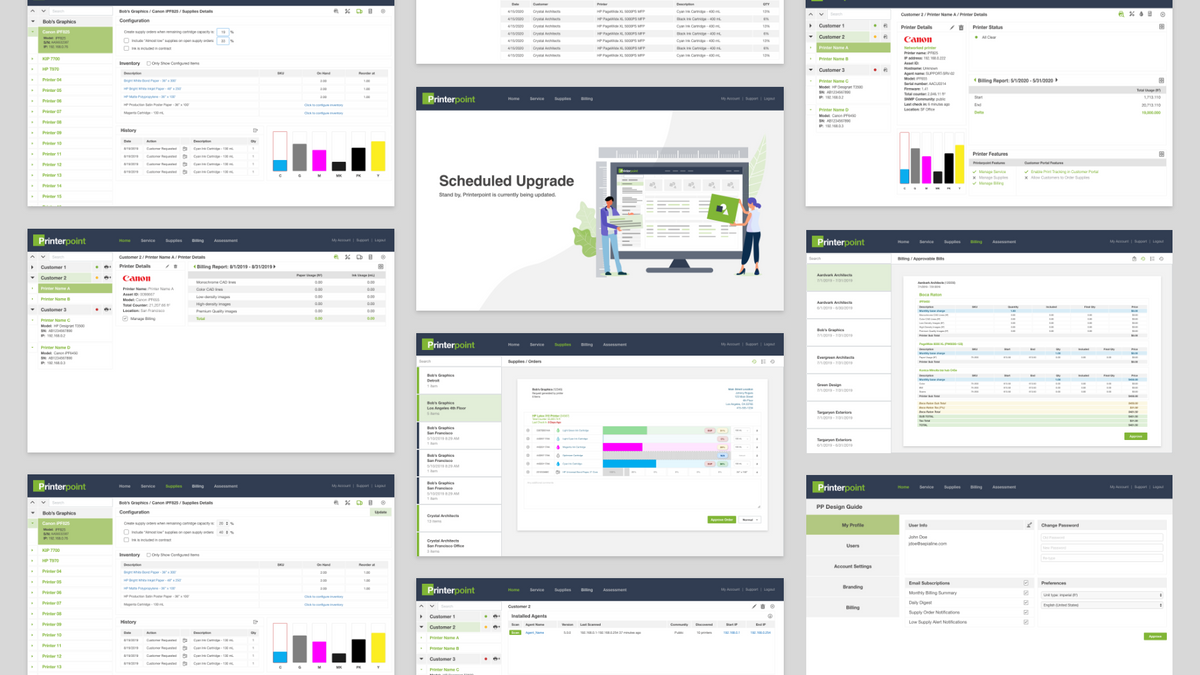A User-Centered Approach to Enterprise SaaS Product Design
A user-centered approach to designing Printerpoint by prioritizing user personas, designing for low technical skills, and partnering with industry leaders.

Sepialine, a renowned company in print tracking software, had established its position as an industry leader for small format printers with millions of seats across the globe. As Sepialine leadership started to focus on rapidly changing technologies for large format printers, Sepialine sought to extend its footprint into this new market. To achieve this, the company hired me as a Creative Director to spearhead the launch of a new enterprise SaaS product, Printerpoint, specifically designed for large format printers. The primary objective was to create a comprehensive solution that would meet the diverse needs of different personas while maintaining a user-friendly interface. In this article, I explore the user-centered approach adopted by my team in the design of Printerpoint, focusing on information architecture, designing for low technical skills, conducting customer interviews, and partnering with industry leaders.
User-Centered Design: How Printerpoint Prioritized User Personas and Pain Points for a Seamless Experience
The design process for Printerpoint began with a thorough understanding of the user personas, their goals, and the specific pain points they faced. My team conducted user interviews and surveys to gain insights into the different user journeys and pain points. By understanding the needs and preferences of our users, my team was able to develop a user-centered design approach that addressed the specific pain points and challenges that users faced.
To further understand the user journey, my team developed user flows and personas that helped to identify and map out the different paths that users could take while using Printerpoint. This approach allowed us to anticipate the user's needs and create an intuitive and user-friendly interface that provided all the necessary information at a glance.
My team's focus on user personas and pain points was critical in creating a seamless experience for Printerpoint users. By understanding the specific challenges that users faced, my team was able to create a solution that was tailored to meet their needs. This approach helped to eliminate unnecessary steps and confusion, allowing users to quickly and easily accomplish their goals while using Printerpoint.
Creating a Consumer-Friendly Experience: How Printerpoint's Design Made the Software Accessible to All Users
Accessibility was a top priority for my team behind Printerpoint. We recognized that users with varying levels of technical skills would need to use the software and that the interface would need to be intuitive and easy to use. To achieve this, my team focused on creating a consumer-like experience for the software.
My team adopted a simple and clean design that incorporated familiar design patterns and icons. This approach made it easy for users to navigate and understand the software, even if they lacked technical expertise. By designing a user interface that was both intuitive and easy to use, my team was able to make Printerpoint accessible to a wide range of users.
Our team's consumer-friendly approach to the design helped to eliminate the need for extensive training, making it easier for users to get started with the software. My team also made sure that the software provided all the necessary information at a glance, further enhancing the user experience.
Collaboration and Integration: The Role of Industry Partnerships in the Development of Printerpoint
When developing an enterprise SaaS product like Printerpoint, partnering with industry leaders is crucial. For Sepialine, partnering with companies like Canon, HP, Xerox, and KIP ensured that Printerpoint could integrate seamlessly with their printers, delivering critical data to printer dealers for service issues, supply levels, inventory, billing, and more. This collaboration played a significant role in creating a comprehensive solution that met the diverse needs of different personas.
Working closely with these industry partners allowed my team to better understand the printer dealers, service managers, and end-users' needs and preferences. We used this knowledge to develop an interface that provided the necessary information at a glance, while also ensuring that the software integrated with the partner printers' functionalities.
By leveraging our partnerships, my team was able to create a solution that was tailored to meet the needs of the different personas. This approach helped to increase the efficiency and effectiveness of the workflow of printer dealers, service managers, and end-users. We were able to achieve this by making Printerpoint easy to use and intuitive, eliminating the need for extensive training or technical knowledge.
Conclusion
Designing an enterprise SaaS product like Printerpoint requires a comprehensive approach that considers the needs of multiple, disparate user personas. A user-centered design approach, starting with information architecture, designing for low technical skills, conducting customer interviews, and partnering with industry leaders are all essential components of the design process. By implementing these strategies, my team was able to create a solution that met the needs of printer dealers, service managers, and end-users, providing a comprehensive solution that enhanced their workflow. Our team's focus on creating a user-friendly interface that was easy to navigate and understand made the software accessible to all users, regardless of their technical expertise. The software's ability to integrate with popular ERP packages such as Deltek further enhanced its functionality, providing users with a complete solution for managing their wide format printing needs.
The design process for an enterprise SaaS product like Printerpoint requires a user-centered approach that considers the needs of multiple, disparate personas. Designing for low technical skills, conducting customer interviews, and partnering with industry leaders are essential components of this process. By implementing these strategies, my team was able to create a comprehensive solution that met the needs of printer dealers, service managers, and end-users, making their workflow more efficient and effective. Printerpoint's success demonstrates the value of a user-centered approach to design, emphasizing the importance of putting the needs and goals of the user at the forefront of the design process.
